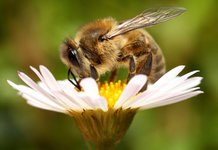
Earlier, I talked about the first work that needs to be done immediately after wintering. Today we go further ...
So, the work that we will carry out with the advent of the first pollen.
First of all, it will be a cursory inspection of families in order to determine the availability of feed and brood.

Families with insufficient feed are fed, and motherless ones join families with a uterus.
If you have available overwintered uterus in nuclei, then the problem with a bezelless family is solved even easier.
In the spring, the first brood appeared in each family, in the brood zone the family raises the temperature strongly, so do not forget about spring warming, and if necessary, reduce it.
A warm and shortened bee family, it is easier to maintain the desired temperature, feed intake, and with it the wear and tear of the bee, is reduced.
Active uterine worming starts from the moment when the bees bring fresh pollen and nectar. But it often happens that there are already pollen bribes, and the nectar has not yet begun. In this case, it is necessary organize incentive feeding. To do this, we need to prepare sugar syrup in a ratio of one to one with water.
Late in the evening, each family should be given 150 to 200 g of this syrup. There is no point in giving more of this amount. Our task is not to feed the family, but to create the illusion of a bribe.

Another important question that for me personally is still open: Is it worth giving families water in non-flying weather?
I somehow divided the apiary into two parts: half of the families poured 100 g of warm water (except for the syrup) into the over-frame drinker every evening, and the other gave only syrup, without water.
Those to whom I gave water willingly took it, even faster than syrup. However, I did not feel the difference in the development of the two control groups. Therefore, let’s leave this moment, let each beekeeper decide for himself: is it worth it or not.
With the advent of the first nectar, when the weight gain on the scales becomes higher than 100 g per day, you can stop the distribution of syrup.
Also a very important procedure that should be carried out in the spring is treatment of bee colonies for varroa tick. I will not dwell on the drugs and technologies that should be applied, I will probably write a separate article about this. I note only that this procedure is required!
Together with the rapid spring development of the bee, the same rapid development of the tick occurs. The task of each beekeeper is to disrupt the cycle of this development and reduce the tick population in the family in the spring to a minimum.
Also to spring work, it is worth attributing first extension. But this must be done carefully and in stages, since reverse cold is possible.
The beekeeper should have a schedule of spring work, and he must strictly adhere to it. After all, it depends on how the apiary works successfully in the May and summer honey harvest.


























